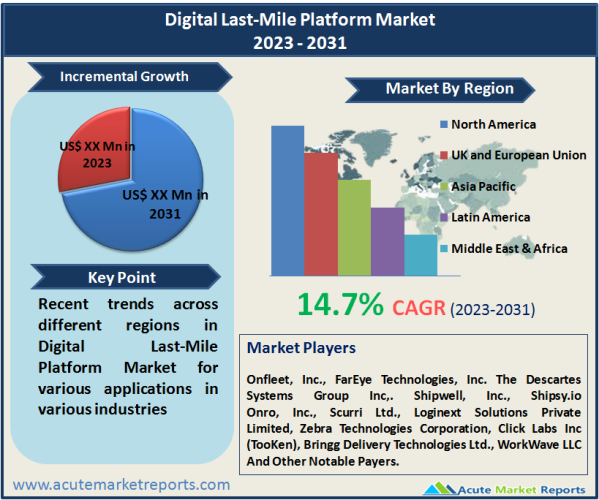
The digital last-mile platform market is expected to witness a CAGR of 14.7% during the forecast period of 2025 to 2033. The digital last-mile platform market is buoyed by drivers such as e-commerce proliferation, urbanization-driven logistics optimization, and the rise of the gig economy. Nevertheless, data security concerns pose a formidable restraint, necessitating a delicate balance between innovation and safeguarding sensitive information. The segmentation of the market by component type and deployment reflects its dynamic nature, with distinct growth prospects for software/platform solutions and services, as well as cloud-based and on-premise deployments. Geographically, regions exhibit diverse trends, while competitive trends underscore key players' strategies to navigate the evolving landscape. As the market progresses from 2025 to 2033, the digital last-mile platform market is poised for continued growth, fueled by technological advancements, changing consumer behavior, and the imperative to enhance last-mile efficiency.

E-commerce Proliferation and Delivery Demands: The rapid proliferation of e-commerce and the burgeoning demand for efficient, timely deliveries have driven the meteoric rise of digital last-mile platforms. The proliferation of online shopping, bolstered by shifting consumer preferences and the convenience of doorstep delivery, has necessitated the optimization of last-mile logistics. In response, companies have harnessed digital technologies to create sophisticated platforms that streamline and orchestrate the complex processes involved in the final leg of delivery. For instance, Company A developed a proprietary platform that integrates route optimization, real-time tracking, and delivery analytics to ensure seamless last-mile execution. The interplay of digital last-mile platforms with e-commerce has thus become a compelling driver for market expansion.
Urbanization and Smart City Initiatives: The ongoing global urbanization wave and the emphasis on smart city initiatives have significantly contributed to the digital last-mile platform market's growth. As cities become denser, the logistical complexities of last-mile delivery intensify. Digital platforms have emerged as a solution, leveraging data analytics, geospatial insights, and artificial intelligence to optimize delivery routes, mitigate traffic congestion, and reduce delivery times. These platforms align with the objectives of smart city initiatives, which seek to enhance urban living through technology-driven efficiency improvements. Company B, a key player, has harnessed the power of smart city infrastructure to deploy digital last-mile platforms that seamlessly integrate with urban mobility systems, ensuring the swift and efficient movement of goods within urban centers.
Rise of Gig Economy and Crowdsourcing: The rise of the gig economy and the advent of crowdsourcing have ushered in new opportunities for digital last-mile platforms. These platforms engage independent contractors and freelancers to perform last-mile deliveries, optimizing resource utilization and enhancing delivery flexibility. The gig economy provides a scalable workforce that can be dynamically deployed based on demand fluctuations. Leading players like Company C have tapped into this trend, creating digital platforms that connect delivery tasks with gig workers, ensuring swift and on-demand delivery services. The convergence of digital platforms and the gig economy has reshaped the delivery landscape, offering cost-effective solutions while also providing income opportunities for gig workers.
Data Security and Privacy Concerns: Amid the rapid digitization of last-mile logistics, data security, and privacy concerns have emerged as significant restraints. The exchange of sensitive customer data, including delivery addresses and contact information, raises potential risks of data breaches and unauthorized access. Ensuring robust cybersecurity measures, complying with data protection regulations, and safeguarding customer privacy emerge as critical challenges for digital last-mile platforms. Companies must invest in advanced encryption protocols, conduct regular cybersecurity audits, and establish stringent data access controls to mitigate these concerns. The imperative to strike a balance between data-driven optimization and safeguarding customer information underscores the complexity of this restraint.
Market Segmentation by Component Type: Software/Platform Solutions Dominates the Market
The digital last-mile platform market can be segmented by component type, encompassing software/platform solutions, and services. While software/platform solutions represented the highest revenue in 2024, offering sophisticated tools for delivery optimization and real-time tracking, services are poised to exhibit the highest Compound Annual Growth Rate (CAGR) during the forecast period from 2025 to 2033. The increasing adoption of platform-as-a-service (PaaS) models and the demand for comprehensive, end-to-end last-mile solutions underpin the anticipated growth of services in the market.
Market Segmentation by Deployment: Cloud-Based Solutions Dominate the Market
Market segmentation by deployment encompasses cloud-based solutions and on-premise deployments. In 2024, cloud-based solutions garnered the highest revenue percentage, benefiting from scalability, remote accessibility, and rapid deployment advantages. However, during the forecast period from 2025 to 2033, on-premise deployments are expected to exhibit the highest CAGR. This growth trajectory is driven by industries with stringent data security requirements and regulatory constraints that favor localized deployment models.
North America Remains as the Global Leader
Geographically, the digital last-mile platform market demonstrates diverse trends, with varying revenue contributions and growth rates. Notably, the Asia-Pacific region is poised to register the highest CAGR during the forecast period. Rapid urbanization, burgeoning e-commerce adoption, and the implementation of smart city initiatives in countries like China and India contribute to this region's robust growth prospects. However, North America generated the highest revenue percentage in 2024, attributed to its mature e-commerce ecosystem, advanced technological infrastructure, and early adoption of digital last-mile platforms.
Market Competition to Intensify during the Forecast Period
Within the digital last-mile platform market, several key players have emerged as industry leaders, each implementing distinctive strategies to secure their competitive foothold and expand their market share. These strategies encompass technological innovation, strategic partnerships, market diversification, and an unwavering customer-centric approach. Leading companies such as Onfleet, Inc., FarEye Technologies, Inc. The Descartes Systems Group Inc,. Shipwell, Inc., Shipsy.io Onro, Inc., Scurri Ltd., Loginext Solutions Private Limited, Zebra Technologies Corporation, Click Labs Inc (TooKen), Bringg Delivery Technologies Ltd., WorkWave LLC and others have demonstrated robust financial performance in 2024, propelled by their ability to offer cutting-edge solutions that address evolving last-mile challenges. These players are poised to leverage their research and development capabilities, enhance service offerings, and capitalize on emerging market opportunities to sustain their growth trajectory from 2025 to 2033. The forecast period is projected to witness heightened investments in data analytics, artificial intelligence, and robotics, underscoring these key players' commitment to shaping the future of digital last-mile logistics.
Historical & Forecast Period
This study report represents analysis of each segment from 2023 to 2033 considering 2024 as the base year. Compounded Annual Growth Rate (CAGR) for each of the respective segments estimated for the forecast period of 2025 to 2033.
The current report comprises of quantitative market estimations for each micro market for every geographical region and qualitative market analysis such as micro and macro environment analysis, market trends, competitive intelligence, segment analysis, porters five force model, top winning strategies, top investment markets, emerging trends and technological analysis, case studies, strategic conclusions and recommendations and other key market insights.
Research Methodology
The complete research study was conducted in three phases, namely: secondary research, primary research, and expert panel review. key data point that enables the estimation of Digital Last-Mile Platform market are as follows:
Market forecast was performed through proprietary software that analyzes various qualitative and quantitative factors. Growth rate and CAGR were estimated through intensive secondary and primary research. Data triangulation across various data points provides accuracy across various analyzed market segments in the report. Application of both top down and bottom-up approach for validation of market estimation assures logical, methodical and mathematical consistency of the quantitative data.
| ATTRIBUTE | DETAILS |
|---|---|
| Research Period | 2023-2033 |
| Base Year | 2024 |
| Forecast Period | 2025-2033 |
| Historical Year | 2023 |
| Unit | USD Million |
| Segmentation | |
Component
| |
Deployment
| |
Application
| |
End-user
| |
|
Region Segment (2023-2033; US$ Million)
|
Key questions answered in this report